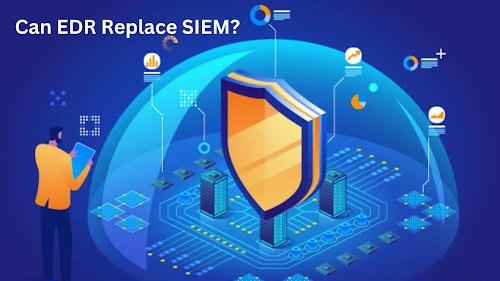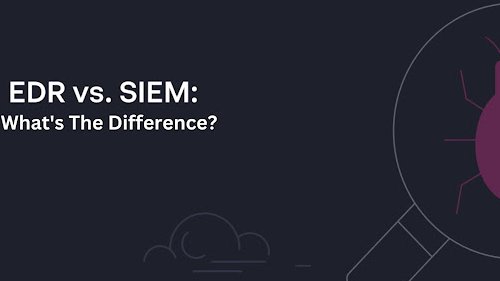Is choosing between EDR and SIEM on your mind right now? Or Can EDR replace SIEM? Regarding cybersecurity, companies may need help implementing an endpoint detection and response system and a security information and event management system.
Both EDR and SIEM have their uses. However, they complement one another more when used together. On the other hand, it might be tempting to prioritize one over the other due to financial constraints or other factors. Let's break it down to its bare essentials to help you choose between EDR and SIEM.
EDR Vs. SIEM
EDR
Next-Generation Anti-Virus is another name for Endpoint Detection and Response (EDR), which was initially known as Endpoint Threat Detection and Response (ETDR) (NG AV).
"Endpoint Detection and Response" (EDR) is a term used in cybersecurity to describe tools that may transform endpoint security from reactive to proactive. For this reason, Gartner reports that "organizations investing in EDR (endpoint detection and response) solutions are deliberately shifting from an 'incident response' approach to one of 'continuous monitoring' in pursuit of problems that they know are continually happening." What exactly is Secure EDR Management? See this page for details.

SIEM
Security Information and Event Management (SIEM) is a platform that gathers information from numerous devices on your network, such as your existing security appliances, and stores it in one place. It has a powerful correlation engine that allows it to proactively detect security events that might otherwise go undetected by individual security tools.
The primary purpose of a security information and event management system is to analyze and report on the log entries collected from various sources. Regarding business security, SIEM systems' analytical skills can identify threats not uncovered by other methods and guide reconfiguring other corporate security policies to close security gaps. Assuming an attack is still in process, some of the best SIEM technologies can halt discovered security breaches.
Differentiating Between EDR and SIEM
Even though they serve distinct purposes, EDR and SIEM may be helpful when used together, particularly in a controlled setting. At its best, a SIEM should be able to identify more threats than EDR. The foundation of SIEM is detection. Having a staff ready to react to any issue is crucial. If all you get from your SIEM is noise and no actionable threats, it may not be worth the investment.
In terms of protection, an EDR ought to be superior to a SIEM. EDR was developed to analyze and avoid problems at the endpoint. However, personnel training, calibration, and maintenance are essential for both EDR and SIEM.
However, the differences between the two conceal their shared goal and highlight the need for an enterprise-wide cybersecurity platform. Integration between cybersecurity solutions and making the most of their combined strengths leads to the best possible results.

Value of SIEM and EDR
Inadequate threat monitoring may lead to problems for businesses, such as lost data, expensive fixes, and penalties for failing to comply with regulations. But there's also the problem of sophisticated cyberattacks, which may have disastrous consequences for your company.
However, no business, no matter how secure, can afford to take implementing effective cybersecurity solutions lightly. While there are some practical differences between SIEM and EDR, both are essential components of any comprehensive cybersecurity program because of the long-term monitoring they provide.
The best way to ensure your network's safety is to use a security information and event management system and an endpoint detection and response tool.
Benefits of SIEM and EDR
Some of the most significant advantages of combining SIEM with EDR are as follows:
Constant monitoring for danger
Continuous network security monitoring is only possible to do with threat response technologies. A SIEM may help you collect security warnings and logs, while an EDR is needed to keep tabs on endpoints. You may rest easy knowing that your security is top-notch since these technologies will provide you with round-the-clock monitoring so you can react quickly to emerging dangers.
An augmentation of network transparency
If you combine various cybersecurity solutions into a single strategy, you can keep a closer eye on more potential threats. Security information event management and endpoint detection and response can help you get a clearer picture of your company's threats by detecting and recording them.
Procedures for handling emergencies
Threat identification is just the beginning of a company's cybersecurity posture. In addition, you should be able to react rapidly to dangers. Fortunately, your team can respond to threats in real-time with the help of SIEM and EDR by receiving real-time warnings.
Solutions that can be scaled up
Tools for keeping your company secure should be scalable. SIEM and EDR are highly scalable and can adapt to your organization's changing demands.
Conclusion Words!
If you're having trouble deciding which option to pursue in Can EDR replace SIEM, it's best to do both. Maintaining a security system that serves as a hub for all of your cyber defense requirements is crucial. This is something that both SIEM and EDR can assist with. Check out our site for additional advice on keeping your network secure.
